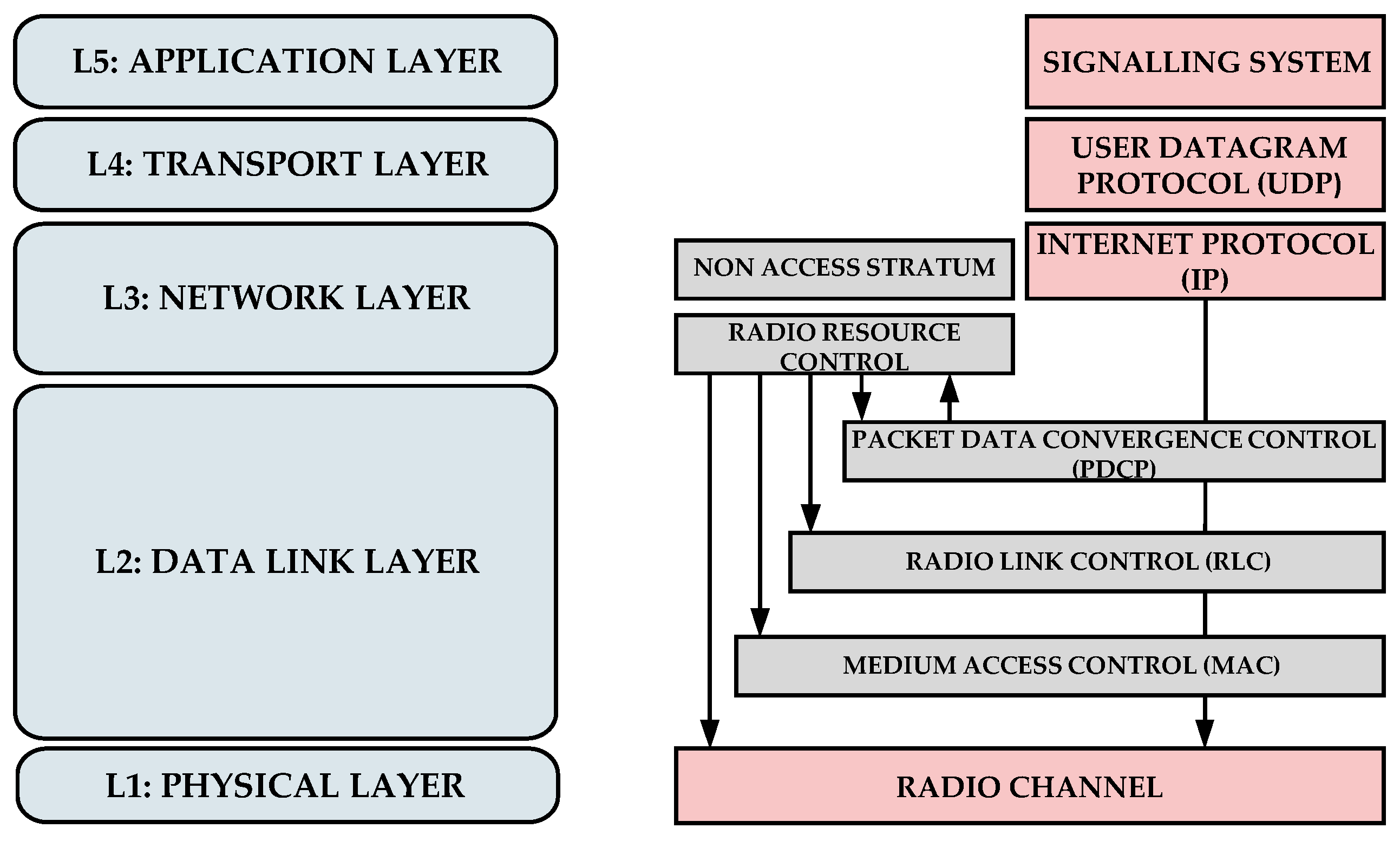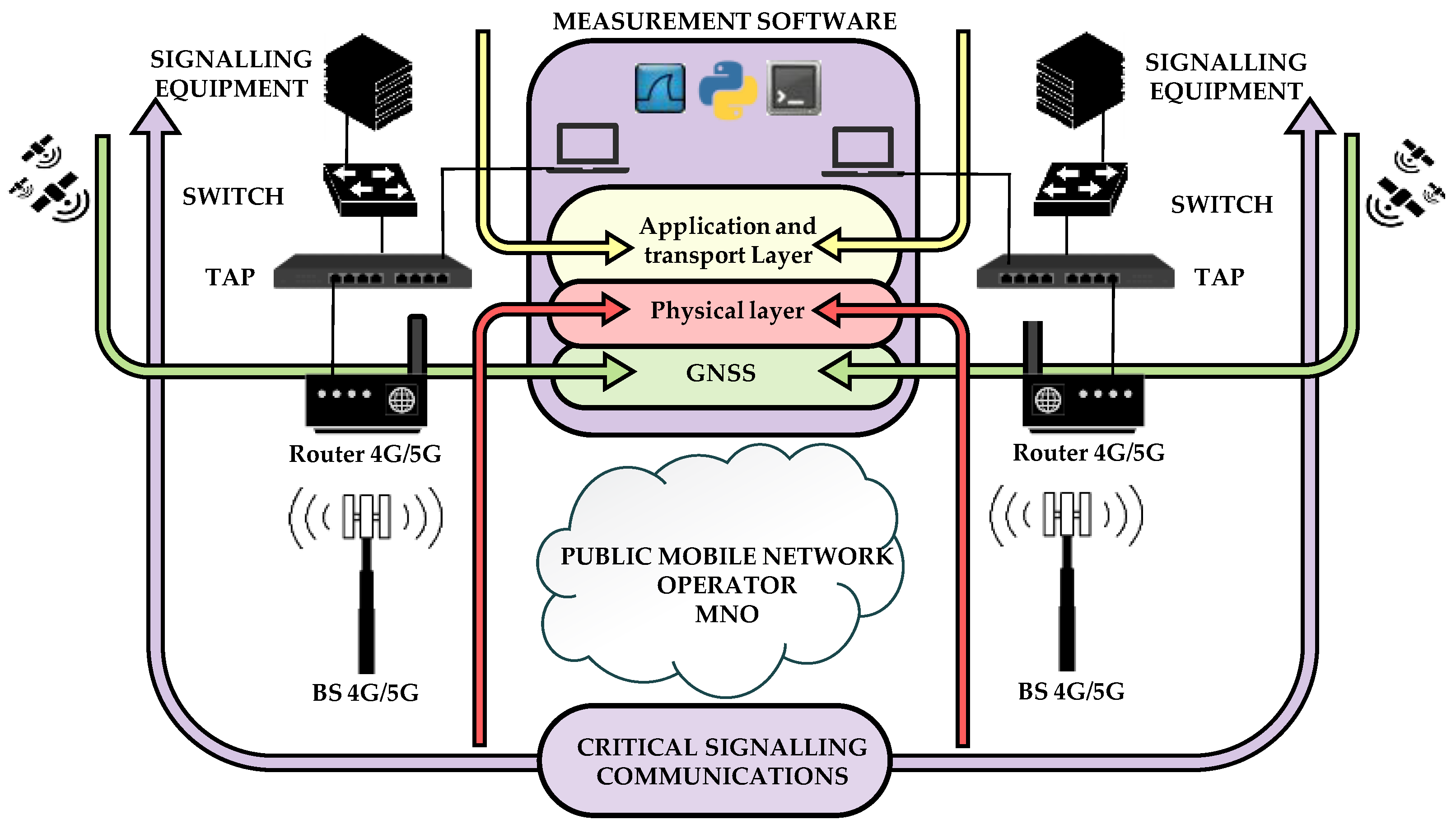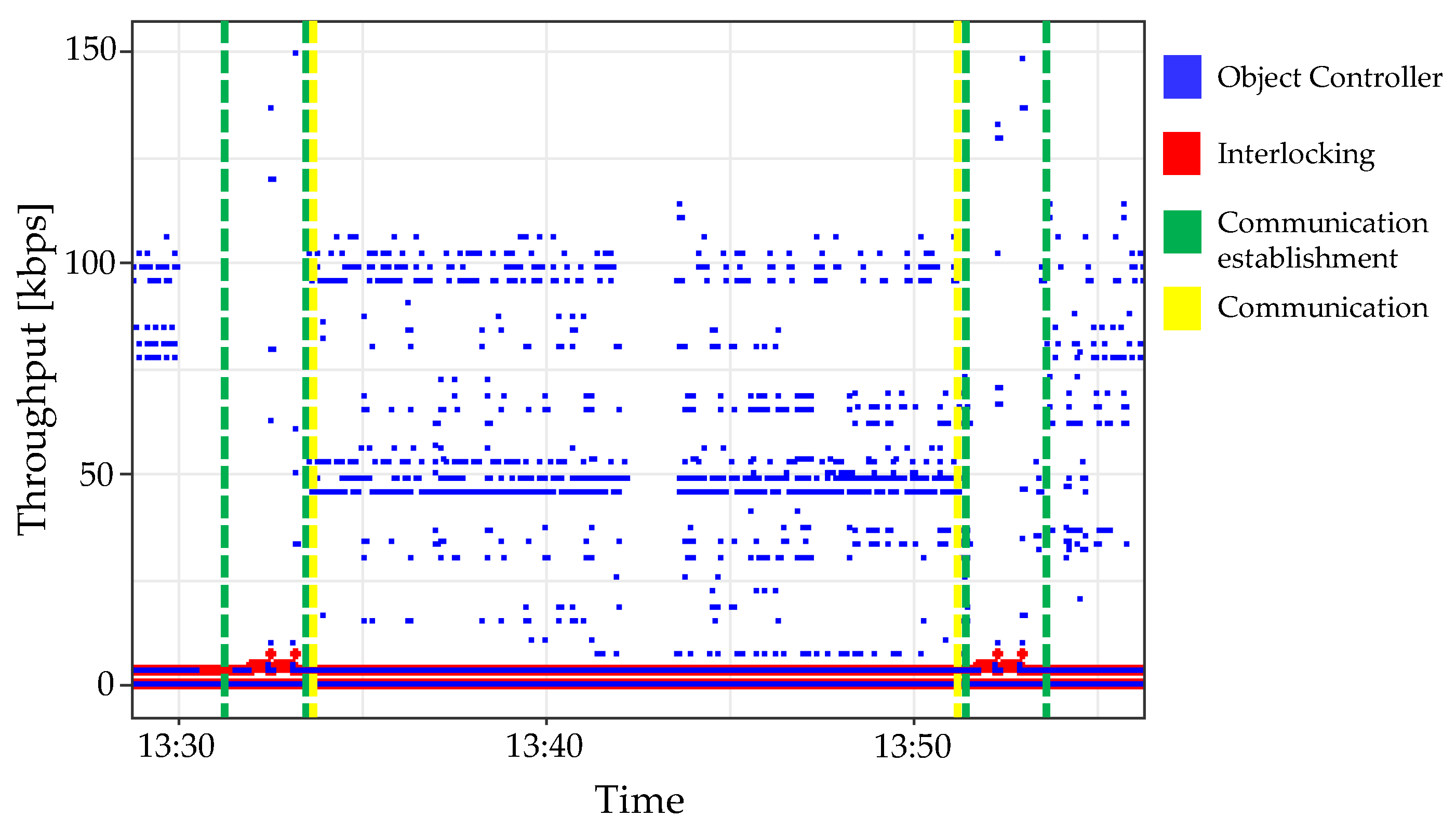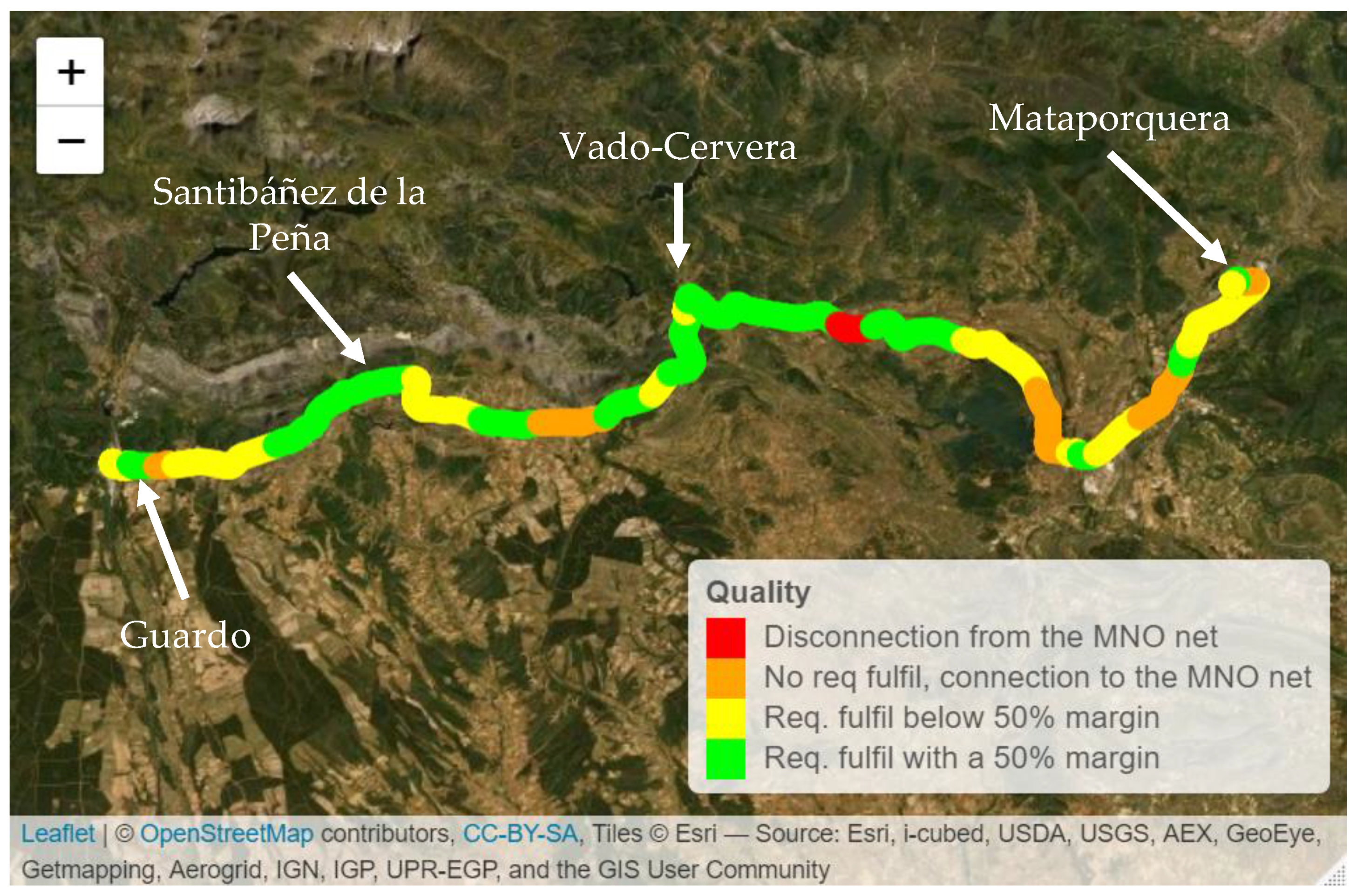5G Based on MNOs for Critical Railway Signalling Services: Future Railway Mobile Communication System
Abstract
:1. Introduction
2. Methodology and Network Design
2.1. Signalling System Requirements
2.2. Protocol Stack Perspective
3. Measurement Set-Up and Prototype
3.1. Prototype Architecture
- Prototype based on commercial equipment as a regular user.
- Prototype based on enterprise solutions with an SLA [13] that guarantees, among other parameters, a maximum latency of 80 ms, a packet loss of 0.2% and a monthly availability of 99.5%.
3.2. Software Scheme
- Measurement software: This section is divided into three modules whose purpose is to request network parameters, and capture and save them.
- -
- Radio and GNSS parameter request module: Developed in Python. It is responsible for requesting, in 1-second intervals, the radio and mobile communication parameters and GNSS parameters, such as speed and geographical coordinates.
- -
- Data capture module: using Wireshark. The wired interface captures the network, transport and application data, whereas the Wifi interface captures the radio and GNSS data.
- -
- Measurement software control module: Developed in ’.cmd’ batch programming, it is responsible for synchronising the two previous modules and saving the data.
- Processing software: Divided into two modules whose purpose is to transform the data and check the quality of the network for signalling services.
- -
- Data processing module: Developed in Python, it is responsible for transforming the files and filtering the resulting files from the measurement software (‘.pcapng’) to others ready for analysis.
- -
- Analysis module: Developed in R, it is responsible for visualising the data and generating statistics to qualify the communication.
3.3. Scenarios
3.3.1. Railway Laboratory Tests
3.3.2. Telecommunications Laboratory Tests
3.3.3. Field Railway Tests
4. Results
4.1. Signalling Data Traffic Characterisation
4.1.1. Bit Rate Characterisation
- Communication establishment: process to establish the communication at the application layer marked between the green vertical lines.
- Signalling tasks marked between the yellow vertical lines:
- -
- Point supervision: periodic task to supervise the state of the point machine;
- -
- Trailing: detection of a point between trailers when the train passes.
- Communication failure: communication establishment and progress not performed successfully at the application level while having connected the communication system correctly.
4.1.2. Latency and Jitter
4.2. Telecommunication Tests
4.2.1. 4G and 5G Characterisation
4.2.2. Comparison between a Regular User and Enterprise Solution with SLA
4.3. Field Measurements
5. Conclusions
Author Contributions
Funding
Institutional Review Board Statement
Informed Consent Statement
Data Availability Statement
Acknowledgments
Conflicts of Interest
Abbreviations
| 4G | Fourth-generation mobile communications |
| 5G | Fifth-generation mobile communications |
| CCTV | Closed Circuit Television |
| CDF | Cumulative Distribution Function |
| dB | Decibel |
| dBm | Decibel-milliwatts |
| DL | Downlink |
| FRMCS | Future Railway Mobile Communication System |
| GNSS | Global Navigation Satellite System |
| GSM-R | Global System for Mobile communications - Railway |
| IoT | Internet of Things |
| IP | Internet Protocol |
| ITS | Intelligent Transport Systems |
| IXL | Interlocking |
| kbps | Kilobits per second |
| KPI | Key Performance Indicator |
| LTE | Long Term Evolution |
| MAC | Medium Access Network |
| MCPTT | Mission Critical Push-To-Talk |
| MNO | Mobile Network Operator |
| MTC | Machine Type Communications |
| ms | Milliseconds |
| NSA | Non-Standalone |
| ObjC | Object Controller |
| OCC | Operation Control Center |
| OFDM | Orthogonal Frequency Division Multiplexing |
| PDCP | Packet Data Convergence Control |
| RLC | Radio Link Control |
| RSRP | Reference Signal Received Power |
| RSRQ | Reference Signal Received Quality |
| SINR | Signal to Interference plus Noise Ratio |
| SLA | Service Level Agreement |
| TAP | Terminal Access Point |
| UDP | User Datagram Protocol |
| UL | Uplink |
References
- Berbineau, M.; Behaegel, R.; Garcia-Loygorri, J.M.; Torrego, R.; D’Errico, R.; Sabra, A.; Yan, Y.; Soler, J. Channel Models for Performance Evaluation of Wireless Systems in Railway Environments. IEEE Access 2021, 9, 45903–45918. [Google Scholar] [CrossRef]
- Zhong, G.; Xiong, K.; Zhong, Z.; Ai, B. Internet of things for high-speed railways. Intell. Converg. Netw. 2021, 2, 115–132. [Google Scholar] [CrossRef]
- Mullner, R.; Ball, C.F.; Ivanov, K.; Treml, F.; Spring, G. Quality of service in GPRS/EDGE mobile radio networks. In Proceedings of the 2004 IEEE 59th Vehicular Technology Conference, Milan, Italy, 17–19 May 2004; Volume 5, pp. 2507–2511. [Google Scholar]
- González-Plaza, A.; Calvo-Ramírez, C.; Briso-Rodríguez, C.; García-Loygorri, J.M.; Oliva, D.; Alonso, J.I. Propagation at mmW Band in Metropolitan Railway Tunnels. Wirel. Commun. Mob. Comput. 2018, 2018, 7350494. [Google Scholar] [CrossRef]
- Chettri, L.; Bera, R. A Comprehensive Survey on Internet of Things (IoT) Toward 5G Wireless Systems. IEEE Internet Things J. 2020, 7, 16–32. [Google Scholar] [CrossRef]
- Arriola, A.; Rodríguez, P.M.; Val, I.; Briso, C.; Gonzalez-Plaza, A.M.; Moreno, J.; Echeverría, E.; Goikoetxea, J. Characterization of an Outdoor-to-Indoor wireless link in metro environments at 2.6 GHz. In Proceedings of the 2017 15th International Conference on ITS Telecommunications (ITST), Warsaw, Poland, 29–31 May 2017; pp. 1–4. [Google Scholar]
- He, D.; Ai, B.; Guan, K.; Zhong, Z.; Hui, B.; Kim, J.; Chung, H.; Kim, I. Channel Measurement, Simulation, and Analysis for High-Speed Railway Communications in 5G Millimeter-Wave Band. IEEE Trans. Intell. Transp. Syst. 2018, 19, 3144–3158. [Google Scholar] [CrossRef]
- Sarfaraz, A.; Hämmäinen, H. 5G Transformation: How mobile network operators are preparing for transformation to 5G? In Proceedings of the 2017 Internet of Things Business Models, Users, and Networks, Copenhagen, Denmark, 23–24 November 2017; pp. 1–9. [Google Scholar] [CrossRef]
- Shah, S.P.; Pattan, B.J.; Gupta, N.; Tangudu, N.D.; Chitturi, S. Service Enabler Layer for 5G Verticals. In Proceedings of the 2020 IEEE 3rd 5G World Forum (5GWF), Bangalore, India, 10–12 September 2020; pp. 269–274. [Google Scholar]
- Gonzalez-Plaza, A.; Moreno, J.; Val, I.; Arriola, A.; Rodriguez, P.M.; Jimenez, F.; Briso, C. 5G communications in high speed and metropolitan railways. In Proceedings of the 2017 11th European Conference on Antennas and Propagation (EUCAP), Paris, France, 19–24 March 2017; pp. 658–660. [Google Scholar]
- Leles, R.D.C.D.; Rodrigues, J.J.P.C.; Woungang, I.W.; Rabel, R.A.L.; Furtado, V. Railways Networks—Challenges for IoT Underground Wireless Communications. In Proceedings of the 2018 IEEE 10th Latin-American Conference on Communications (LATINCOM), Guadalajara, Mexico, 14–16 November 2018; pp. 1–6. [Google Scholar]
- Du, K.X.; Carrozzo, G.; Siddiqui, M.S.; Carrasco, O.; Sayadi, B.; Lazarakis, F.; Kourtis, A.; Sterle, J.; Bruschi, R. Definition and Evaluation of Latency in 5G: A Framework Approach. In Proceedings of the 2019 IEEE 2nd 5G World Forum (5GWF), Dresden, Germany, 30 September–2 October 2019; pp. 135–140. [Google Scholar]
- Chounos, K.; Apostolaras, A.; Korakis, T. A Dynamic Pricing and Leasing Module for 5G Networks. In Proceedings of the 2020 IEEE 3rd 5G World Forum (5GWF), Bangalore, India, 10–12 September 2020; pp. 343–348. [Google Scholar]









| Communication Requirements for Signalling Equipment | |
|---|---|
| Communication protocol | UDP/IP |
| Message reception timeout | 1.8 s |
| Message sending period | 300 ms |
| Signalling bit rate | 4 kpbs |
| Availability | >99% |
| Parameters | Theoretical Value | Average Measured Value |
|---|---|---|
| Bit Rate | ||
| Overall bit rate | 3.8 kbps | Interlocking: |
| Trailing tests | Trailing: 2.8 kbps | |
| Supervision tests | Supervision: 3.3 kbps | |
| Signalling comms failure | Failure: 7.5 kbps | |
| Object Controller: | ||
| Trailing: 2.2 kbps | ||
| Supervision: 4.8 kbps | ||
| Failure: 2.5 kbps | ||
| Time | ||
| Signalling layer round trip time | <1800 ms | 601 ms |
| Network delay (Latency) | <500 ms | 70 ms |
| Messages period (Jitter) | 300 ms | 318 ms |
| LTE (4G) | 5G NSA | |||
|---|---|---|---|---|
| Parameter | Radio | Latency | Radio | Latency |
| RSRP | −109 dBm | 300 ms | −120 dBm | 150 ms |
| RSRQ | −12 dB | 300 ms | No minimum value obtained | |
| SINR | 10 dB | 220 ms | No minimum value obtained | |
Publisher’s Note: MDPI stays neutral with regard to jurisdictional claims in published maps and institutional affiliations. |
© 2022 by the authors. Licensee MDPI, Basel, Switzerland. This article is an open access article distributed under the terms and conditions of the Creative Commons Attribution (CC BY) license (https://creativecommons.org/licenses/by/4.0/).
Share and Cite
González-Plaza, A.; Gutiérrez Cantarero, R.; Arancibia Banda, R.B.; Briso Rodríguez, C. 5G Based on MNOs for Critical Railway Signalling Services: Future Railway Mobile Communication System. Appl. Sci. 2022, 12, 9003. https://doi.org/10.3390/app12189003
González-Plaza A, Gutiérrez Cantarero R, Arancibia Banda RB, Briso Rodríguez C. 5G Based on MNOs for Critical Railway Signalling Services: Future Railway Mobile Communication System. Applied Sciences. 2022; 12(18):9003. https://doi.org/10.3390/app12189003
Chicago/Turabian StyleGonzález-Plaza, Ana, Rafael Gutiérrez Cantarero, Rafael B. Arancibia Banda, and César Briso Rodríguez. 2022. "5G Based on MNOs for Critical Railway Signalling Services: Future Railway Mobile Communication System" Applied Sciences 12, no. 18: 9003. https://doi.org/10.3390/app12189003
APA StyleGonzález-Plaza, A., Gutiérrez Cantarero, R., Arancibia Banda, R. B., & Briso Rodríguez, C. (2022). 5G Based on MNOs for Critical Railway Signalling Services: Future Railway Mobile Communication System. Applied Sciences, 12(18), 9003. https://doi.org/10.3390/app12189003







